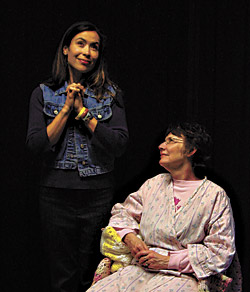
Van Peebles in Badasssss!
photo: Michael oConnor/ sony pictures Classics |
What struck me most while attending the Sundance Film Festival last week was not the inside skinny on Cameron Crowe’s attempt to revive festgoer Jane Fonda’s career (she needs to embrace his spontaneous style and transcend her control-freaky limitations by co-starring in his upcoming Elizabethtown); nor the sight of the 10th-most-important, first-cutest film critic in America drunkenly complaining about how unbearably horny and bitterly envious the sizzling on-screen sex scenes made said critic feel; nor even the come-hither grin of the blonde who slunk up to me and cooed, “I loved your film!” (I explained I had no film; now my wife says I passed the Husband Test.)
No, the top story about the latest graduating class of American indies is how most of the buzz and prizes went either to documentaries or to films whose fictions spring from a reality-documenting sensibility.

Giants director Stacy Peralta
photo: Anthony Friedkin Sony Pictures Classics |
IN THE FORMER CAMP, a video memoir made for about $200 and edited on Apple’s iMovie is the only flat-out masterpiece I saw at Sundance. “It’s the shit,” concurs Gus Van Sant, who took one look at it and signed on as exec producer to Jonathan Couette’s Tarnation. It’s the story of a Texas boy and his moma schizophrenic drop-dead child-star beauty who, after protracted electroshock assault, lit out for the territory with her little boy and wound up getting raped before his eyes. Then things got scarier. A stagestruck pack rat, Couette preserved scads of video and photos documenting his life with his psycho mother and his own extraordinarily troubled times: the new-wave acting out; the first joints soaked in PCP and formaldehyde; the high-school musical production of Blue Velvet with songs by Marianne Faithfull; the move to New York pursued by the heartbreaking wraith of his mom and their memories. At 11, Couette could impersonate a battered white-trash housewife spot on, but the role of his life was . . . well, his life. He and his theatrical mom are searing presences on-screen, and the iMovie manipulation of the home-movie imagery is virtuosic. Kids, schmids. Crumb, schmumb. Tarnation is the cinematic shit.

James Hetfield in Monster
photo: Joe Berlinger |
And yet, even this, the ultimate personal documentary, makes me suspect the hand of the artist on the scales of history. Couette claims that “records now indicate” that his mom was sane before electroshock, but does ECT really cause schizophrenia? His mom’s last appearance in the film is excruciatingly crazy, suggesting she’s a goner; in fact, he says she’s gotten much better since. I believe he, too, sculpts reality, just as Allen Ginsberg did in his masterpiece Kaddish and Robert Stone did in his fiction about his schizo mother.

Tarnation
photo: Discovery Times Channel/ 7th Art Releasing |
Other standout docs also had their share of art to them. The thunderously entertaining surfing history Riding Giants, by the director of the popular skateboard history Dogtown and Z-Boys, became the first documentary chosen to open Sundance; it got bought and could kick up some modest cash tsunamis. Following last year’s spelling-bee hit, Spellbound, we got Word Wars, the Gladiator of eccentric-Scrabble-champ flicks. Super Size Me, in which a man eats only at McDonald’s for a month and nearly dies a fat bastard in the process, may do for cineplexes what Fast Food Nation did for best-seller lists. Riding the Billboard charts, the authentically scrambled lives of rock stars produced the Dandy Warhols tell-all Dig! (the festival’s top doc prizewinner) and the touted Metallica: Some Kind of Monster.
The Corporation tells such hair-raising tales of boardroom malevolence it could shock a conscience into Karl Rovebut it tells them at such length most of the press-screening audience at Sundance walked out. Still, in the age of Michael Moore, it might find an audience. Besides, how can you not love a movie that claims corporations fulfill the American Psychiatric Association’s Diagnostic and Statistical Manual’s standard definition of the psychotic personality?

Super Size Me
photo: Julie Soefer |
IN THE LATTER CAMP, the big hit Open Water is a kind of low-budget Jaws with a Blair Witch whiff; it was inspired by a true story of a couple lost at sea while scuba diving. Down to the Bone nabbed two awards (for directing and acting), not on the strength of its wispy plot, but obviously because it, and rising indie star Vera Farmiga, so truthfully capture what life is really like for an ordinary middle-class American coke addict. Maria Full of Grace tried to honor with comparable realism a Colombian “mule” who smuggles heroin in her belly (it won Sundance’s Dramatic Audience Award). Hollywood screens are awash in junkies and smugglers, but these directors smuggle some real life into movies right under the studios’ noses.
Maria is likely meant to be marketed to Hispanic audiences, and further proof of the increasing clout of America’s No. 1 minority is the Sundance sale of The Motorcycle Diaries, based on Che Guevara’s nine-month Easy Rider odyssey through South America on a Norton 500, which roused him from young med student to future revolutionary.
Director Mario Van Peebles strove for realism in re-creating the making of his father Melvin’s 1971 film Sweet Sweetback’s Baadasssss Song, but he admitted in the Q&A that the Sweetback scene in which Mario made his teenage acting debut as a kid losing his virginity didn’t actually happen the way he portrays it in his re-creation (confusingly retitled Baadasssss!). The character who plays the young Mario is horribly embarrassed by the sex scene, while grown-up Mario said that he came from such a nudist family that it never fazed him for a minute. He reshaped his own real experience for artistic effect, like Tarnation‘s Couette, only without bothering about the documentary versus nondocumentary label. All of which bears out Nabokov’s remark that the word “reality” should never appear except in quotes.

a Word Wars player
photo: courtesy of Sundance |
BUT WILL ANY of these films sell? In the mainstream market, is there any future for the docs and quasi-docs that dominated Sundance ’04? Just a few years ago, the answer would be no. But things are changing. The AMPAS, which formerly reserved its Oscar category for its most brainless, ignorant, and tasteless tastemakers, is trying to redeem itself after its scandalous underachievement was exposed. More important, the mania for reality that engulfs TV is also reflected, to a lesser extent, in big-screen box-office stampedes. Last year’s Sundance hybrid hit American Splendor grossed $6 million in U.S. theaters, so Americans clearly didn’t care whether it was all doc, part doc, or what. It may yet collect enough awardsand not just from Seattle criticsto earn even more money when it bows on DVD (Feb. 3).
I guess this year’s Sundance shows that there’s a reality for everybody. And if you don’t like what you see, you can make your own damn movie. Chances are, I’ll be seeing it there next year.







